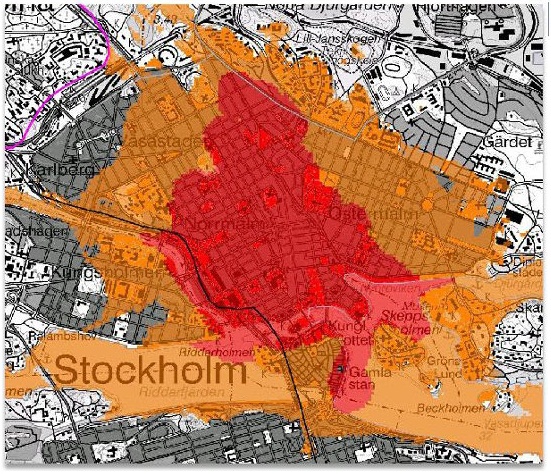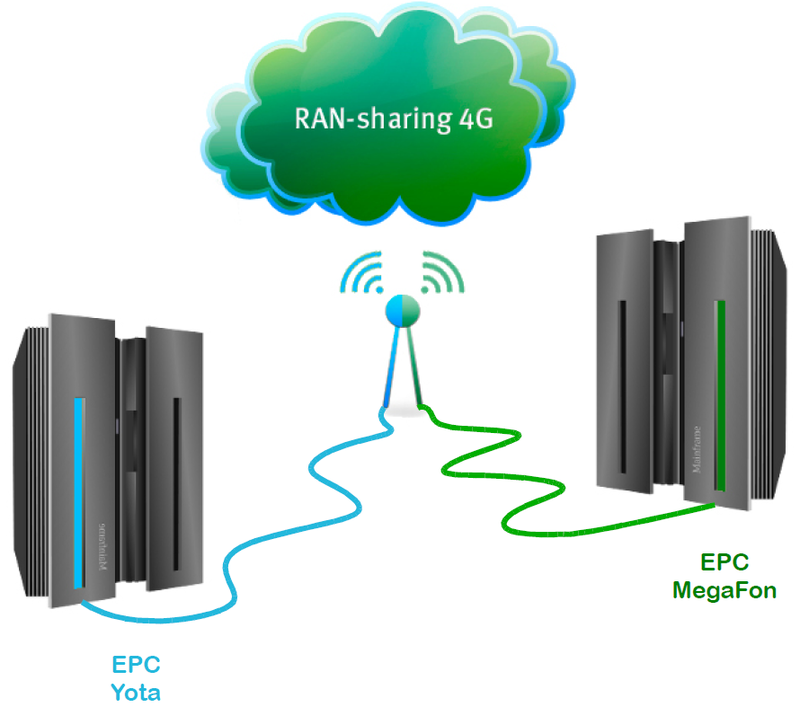What is LTE and 4G from MegaFon
LTE?
What is LTE? Is this 4G? What is it like, why can't you buy an LTE terminal in America and work on it in Europe? These, and not only, questions arise in any person facing LTE.
Theory.
LTE - Long Term Evolution , evolution with a “good” perspective (you can argue about translation, but this is exactly the option that comes close to the point) . According to 3GPP 4G standard corresponds to LTE Advanced, so this is not a reference 4G yet. LTE, in certain circles, is called pre-4G. We will not be upset and consider more LTE.
In the radio part, new modulation methods are applied: OFDM on downlink and SC-FDMA on uplink. The MIMO technology that was used in HSPA + (2x2 antennas) was further developed (4x4 antennas and more, depending on the release of 3GPP and terminal support).

')
All this helped to get a higher bandwidth of the radio interface (300 Mbit / s on Downlink and up to 75 Mbit / s on Uplink) . Looking ahead, I will say that on the test base we received speeds of 80 - 85 Mbit / s on the downlink.
Not to mention the access methods with frequency (FDD) and time (TDD) channel separation, which together with different carrier frequencies prevent us from using one terminal, for example in Russia and the USA. (all frequency bands approved by 3GPP for use in LTE can be viewed here ) Although the leading manufacturers of LTE equipment are already integrating both technologies in one chip, which will help to avoid these inconveniences.
The advantage of FDD is a lower interference between neighboring BSs and a higher downlink speed on the same channel width with TDD (the downlink speed in TDD on the 20 MHz channel corresponds to the speed in FDD on the 15 MHz channel) . TDD, on the other hand, uses resources more efficiently with an asymmetric channel (which is the channel in mobile communication) , since in TDD it is possible to adjust the ratio of resources for downlink / uplink. Therefore, both FDD and TDD have found their place in modern LTE networks.
Drastic changes were made to the core of the network. In LTE, we forgot about the good old OKS7 and switched to the new protocol - DIAMETER (based on IP). All signaling interfaces between network elements work using the DIAMETER protocol, with the exception of legacy 3G elements, connections to which take place via SIGTRAN (again, IP).

A detailed description of the elements and their tasks can be found, for example, here .
LTE in the world.
Europe
As a historical reference, let's look at the world's first LTE network launched in Europe on December 14, 2009. The network was commissioned by TeliaSonera in Stockholm and Oslo. The network covered the central regions of the capitals of Norway and Sweden - about 150,000 people in Oslo, and 300,000 in Stockholm. The expected data rates are from 20 to 80 Mbit / s. Another interesting point is that Huawei supplied the equipment for the radio part and the network core in Oslo, and Ericsson supplied the equipment to Stockholm.

How much is the first in the world to get wireless broadband?
According to the online magazine Light Reading :
At launch, an advertising campaign was conducted, and the cost of using LTE per month was $ 52.
After launch into commercial operation the following tariffs were offered:
- Telia Mobile Broadband Mellan (medium): 199 SEK ($ 30) per month for a 10GB data packet, access to 3G and WiFi; for an additional 100 Swedish kronor ($ 14)) per month it was possible to get 4G access at a speed of 5Mbit / s - 10Mbit / s.
- Telia Mobile Broadband Stor (large): 269 SEK ($ 40) per month, for a 20GB data packet, access to 3G and WiFi; for an extra 100 Swedish kronor ($ 14) per month, per month it was possible to get 4G access at a speed of 10Mbit / s - 20Mbit / s.
- Telia Mobile Broadband Total 4G: 599 SEK ($ 88) per month for 4G access at a speed of 10Mbit / s - 80Mbit / s, and a data packet of 30GB, as well as access to 3G and WiFi.
According to 2012 data, the TeliaSonera LTE user base reached 100,000 users in 7 countries in the Baltic and Scandinavia.
America
In America, one of the first LTE networks was launched by Verizon. As of the beginning of December 2010, the network covered 38 US cities, offering a data transfer rate of 5-12 Mbit / s for downlink and 2-5 Mbit / s for uplink.
According to the latest Verizon data, LTE coverage is 75% of the US population and is present in 371 cities.

According to the analytical agency Mosaik Solution, Verizon’s LTE network coverage is a bit more modest. There is also a comparison with the AT & T network coverage:

Pay attention to the tariffs for mobile communications subscribers Verizon:
The cost of unlimited calls and SMS for each smartphone is $ 40 (several phones can be connected to the tariff plan) , this amount does not include data transfer.
Verizon has completely abandoned unlimited data plans. The cost of data transfer depends on the selected package: 1 GB for $ 50, 2 GB for $ 60, 4 GB for $ 70, 6 GB for $ 80, 8 GB for $ 90, and 10 GB for $ 100.00.
Up to 10 devices can be connected to the selected package, with an additional payment for exceeding the amount of data in the package at $ 15 per 1 GB. Plus, you will have to pay an additional fee for each device separately: a $ 10 tablet, a $ 20 USB modem.
In general, in the world, according to the latest data of the GSA (Global Semiconductor Alliance) Association, construction planning is underway or 292 LTE networks are already being deployed in 93 countries, including 96 networks that have already been commercially launched in 46 countries.
In addition, another 55 mobile operators in 11 countries are launching LTE pilot networks.
Thus, it turns out that 347 operators in 104 countries are currently investing in mobile communication networks based on LTE technology.
According to the same association, as of December 31, 2012, 152 networks in 65 countries will be commercially launched.
LTE MegaFon. How to get two from one network.
Through collaboration with Scartel, the issue of “Frequency Licenses” was resolved,
But this is not the only area of cooperation. 3GPP has developed the MOCN (Multi-Operator Core Network) concept. Why build two bad radio networks if you can build one good one and include two cores in it?

The basic principle that allows the use of LTE Sharing is the transmission to the eNodeB via the PLMN ID broadcast channel (Public Land Mobile Network ID consisting of Mobile Country Code and Mobile Network Code). The eNodeB uses the PLMN ID to select a network and in turn MME.
By this principle we went too. Having a good infrastructure, built during the 3G deployment, we, together with Scartel, included the LTE - eNodeB radio part, launched on the same sites of 3G bases, into ready-made transport. This greatly accelerated network deployment. Of course, the transport network itself is also being improved and improved.
Regarding the network core configuration (EPC): in addition to the configuration of the equipment itself, the HSS and MME signal connections were configured by DIAMETER, and their own with 3G elements by SIGTRAN (SGSN, MSC). Everyone understood that in addition to being able to get LTE network services, we would also need a “seamless” terminal transition between LTE-3G-2G networks. We are talking only about packet data, since LTE does not have a CS (circuit switching) domain, and therefore, providing a CS voice call is impossible. By means of LTE (VoLTE - Voice Over LTE), the organization of voice transmission is envisaged, but if there is a deployed and functioning IMS (IP Multimedia Subsystem) network, which is currently not present. How to be?
And again, the 3GPP consortium comes to our rescue. 3GPP has developed a procedure for providing voice service in the LTE network at an early stage, as long as there is no full-fledged IMS, using the CS domain 2G / 3G networks. This technology is called CSFB (Circuit Switched Fallback). The basic idea is that when an outgoing / incoming call is in the LTE network, the subscriber is “pushed” from 4G to 2G / 3G network by exchanging signaling messages between the MME and the MSC. In this case, the voice call is carried out according to the standard procedure for the CS domain.
It would seem that everything, data transfer and voice is - the network is running. But, roaming between LTE networks, and LTE-UMTS-GSM, VoLTE networks (in perspective) and other services has yet to be set up.
But that's another story. LTE and LTE-Advanced is quite an interesting and voluminous topic, so if there is interest, we are ready to continue and form a series of articles and consider the technology in more detail.
Source: https://habr.com/ru/post/154153/
All Articles